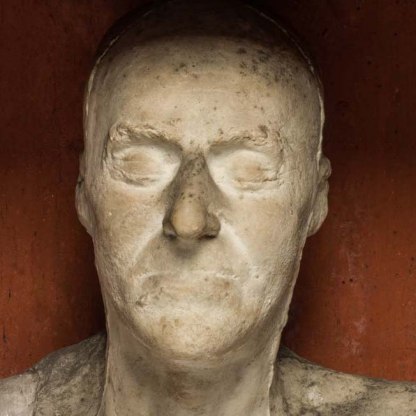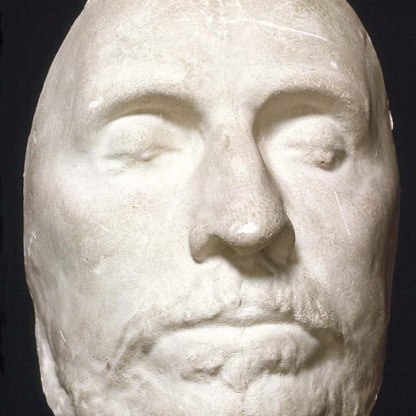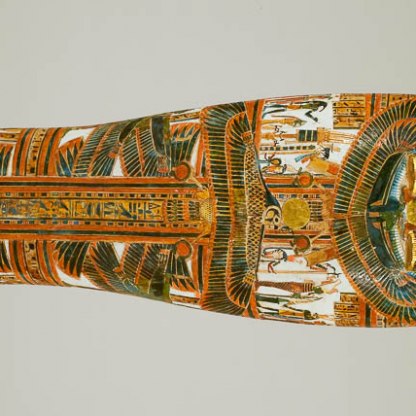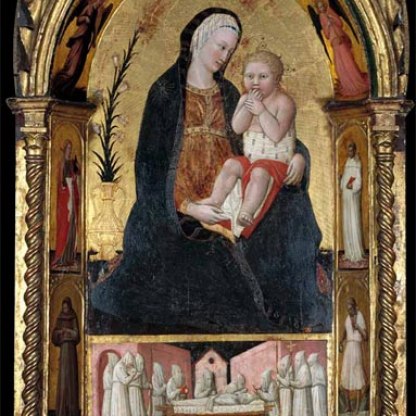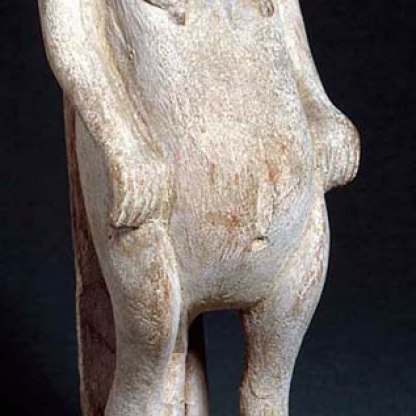Death Mask of Oliver Cromwell

I saw him dead, a leaden slumber lyes And mortall sleep over those wakefull eys ... Yet dwelt that greatnesse in his shape decay’d That still though dead greater than death he lay’d ...
Andrew Marvell, A Poem Upon the Death of O. C.
This plaster copy of the death mask of Oliver Cromwell illustrates well Andrew Marvell’s lyrical eyewitness account. Something of the man’s charisma can still be gleaned from the white, plaster features. There is somehow a sense of sleep having closed those eyes.
The original wax mask, of which this is a plaster copy, was probably taken as a model for Cromwell's funeral effigy. He had died on 3 September 1658, and his corpse had been quietly buried in Westminster Abbey on 10 November. But, despite refusing to take on the title of king in his own lifetime, he was accorded elaborate funeral rites based upon those that had marked the passing of King James I in 1625.
A wooden model was made of his body, topped by a wax head, and for eleven weeks this effigy, holding a sceptre and orb and dressed in the traditional royal garb of velvet and ermine, lay in state in Somerset House on the Strand in London. On 23 November it was solemnly processed to Westminster Abbey. The short journey took seven hours.
A special gold medal was issued and distributed to offical mourners at the state funeral – a Dutch copy of one of these can be seen, left. But despite the elaborate and vastly expensive public display of grief, the Lord Protector’s death was not universally mourned. An anonymous poet of the time crudely recorded his pleasure at Cromwell's passing,
... Oliver’s dead, that hellish imp of Mars / Whence is his nose sure in the divell’s arse ...
He did not lie long within his grave, however, and the subsequent history of Cromwells head is as bizarre as it is grisly.
In May 1660, the monarchy was restored in England and Charles II, son of the executed king, took the throne. Cromwell was disinterred in January 1661 and on the anniversary of the execution of Charles I, his corpse was strung up and beheaded at Tyburn, London’s principal place of execution. The head was displayed on the top of a pole for over twenty years, a vivid and macabre warning against Republicanism. Sometime after 1684, however, perhaps after being blown down in a gale, it disappeared.
The head emerged again, understandably battered, as a collector's item in the eighteenth century, when it changed hands several times. In 1787, for instance, a certain James Cox paid the actor-manager Samuel Russel(l) £118 for it. Cox went on to make a profit, selling it for £230 to three brothers called Hughes, who put it on public display in London in 1799.
By 1814 it was the treasured possession of Josiah Henry Wilkinson, in whose family it stayed until the twentieth century. In 1935, Canon Horace Wilkinson allowed scientists to test the relic for authenticity. They concluded that the head was indeed that of Cromwell and, after Wilkinson's death, it was deposited in a bank vault in Woodbridge, Suffolk. Left is a photograph of the canon holding his gruesome collectible. It is reproduced by kind permission of the Master and Fellows of Sidney Sussex College, Cambridge.
In 1960, nearly three hundred years after it was hacked off at Tyburn, Cromwell’s head was reburied in the chapel of Sidney Sussex, his old Cambridge college. The exact location remains a secret.
Cromwell’s dead face is still able to stir up strong passions today. As recently as spring 2001, a copy of his death mask, similar to this one, was displayed at the heritage centre in Drogheda, Ireland, where Cromwell was accused of having massacred 4,000 civilians. There were violent public protests and calls for its removal. 'I can’t sleep at night thinking about the bugger', said a local councillor Frank Godfrey, 'He’s caused enough pain in these parts – let them take him back where he belongs.'
Themes and periods
Data from our collections database
Plaster, cast, with a non-ferrous suspension hook
Legal notes
Given by Mrs Laurence Humphrey
Acquisition and important dates
- Method of acquisition: Given
- Dates: 1912-08-15
Dating
- 1910s
- Production date: before AD 1912
Maker(s)
- Unknown Production
Place(s) associated
- England
Materials used in production
Read more about this recordStories, Contexts and Themes
Other highlight objects you might like
Suggested Curating Cambridge products
Sign up to our emails
Be the first to hear about our news, exhibitions, events and more…
